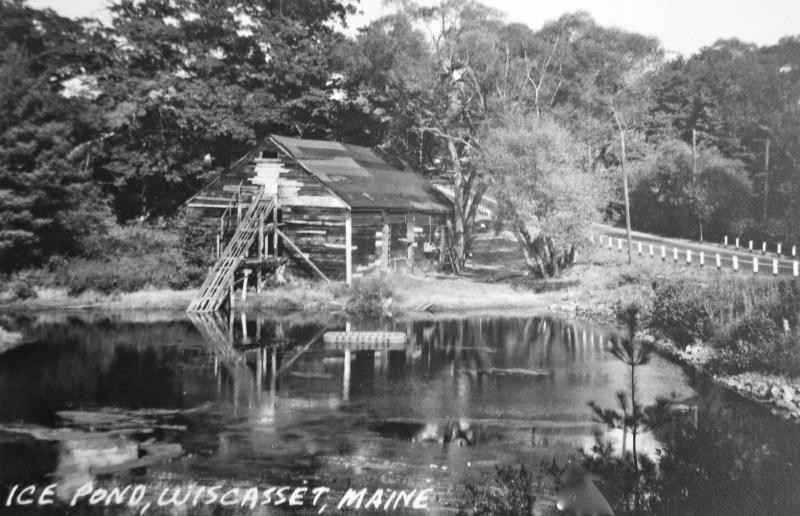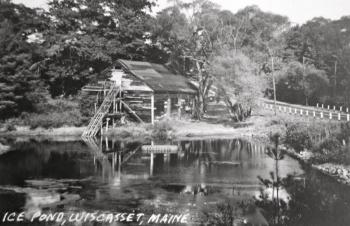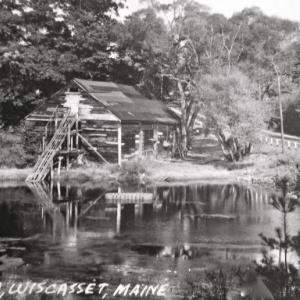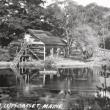February once included ice harvesting
 By the late 1950s not much remained of the icehouse where by E. W. Holbrook operated his ice business. This nostalgic postcard shows the small body of water at the junction of Old Bath Road and Route 1 still know as Holbrook’s Pond.
By the late 1950s not much remained of the icehouse where by E. W. Holbrook operated his ice business. This nostalgic postcard shows the small body of water at the junction of Old Bath Road and Route 1 still know as Holbrook’s Pond.
 By the late 1950s not much remained of the icehouse where by E. W. Holbrook operated his ice business. This nostalgic postcard shows the small body of water at the junction of Old Bath Road and Route 1 still know as Holbrook’s Pond.
By the late 1950s not much remained of the icehouse where by E. W. Holbrook operated his ice business. This nostalgic postcard shows the small body of water at the junction of Old Bath Road and Route 1 still know as Holbrook’s Pond.
It’s taken a while but the really frigid temperatures have finally set in this winter, freezing many lakes and ponds. Years ago, before refrigeration came into being, this was the time of year when ice harvesting was at its peak.
There were a number of ice manufacturers in the area including Wiscasset, Woolwich and Edgecomb. The industry thrived from the mid-1800s well into the 1940s.
Although the ice industry has disappeared, you can still see many of the places where this activity was carried out. One of the largest ice operations in Wiscasset was south of the village in what’s now a large cove. It’s located at the entrance of Cushman Mountain Preserve off Birch Point Road behind Mason Station, the former power plant.
Known today as “Ice Pond Cove,” this body of water has had several names over the years. It was known as “Boom Cove” in the 19th century because it’s here timber was stored in “logging booms,” floating rafts of timber used to supply nearby sawmills.
An engineering map from 1913 refers to this same body of water as “Stinson Pond,” named for James Stinson, another former property owner. From old town records we learn Stinson, too, was involved in the lumber trade. An old deed reveals he purchased a large tract of Birch Point in 1848 where he farmed and operated a sawmill. Earlier he held a stake in Clark & Co.’s Steam Mills located on nearby Holbrook’s Island, now called White’s island.
After embarking on his own, Stinson concentrated his business enterprises on Birch Point where he also made his home. Along with farming he also raised sheep. When he died in 1855, the sawmill passed to a son, David G. Stinson. It was the younger Stinson who expanded into the ice business. He later sold both the lumber mill and ice pond to Ira Sturgis, a successful businessman from Augusta.
Sturgis erected a three-story steam-powered lumber mill on the riverbank. Along with finished lumber, it milled shingles, clapboard and lath. Sturgis also convinced Wiscasset’s town fathers to build a bridge his workers could use linking Holbrook’s Island to Birch Point. The wooden bridge was sturdy enough for heavily laden horse and wagons to use. Before it fell into disrepair and was dismantled, it was the route most Wiscasset folks relied on to get from the south end of town to the village.
It was Sturgis’s son-in-law, J. Manchester Haynes, who further expanded the ice business. Haynes built three wood-framed ice houses and shored up the earthen dike separating the cove from the river. The ice houses were large enough to store 16,000 tons of ice. One was located alongside the mill on the shore of the Sheepscot River. Traces of the mill and ice houses can be found in the mudflat. Most of the dike is gone, returning the cove to the influences of the tide.
The ice harvesting began in mid-winter after the ice had frozen to a depth of no less than 12 inches, although the thicker it was, the better. Spring-fed pond or lake ice was greatly preferred to river ice because it froze more evenly and was freer of sediment.
The first task would be to shovel away any snow from the surface. The ice was then swept clean and skillfully scored or “grooved” into large squares, something like a checkerboard. This was sometimes done by a man slowly pushing a grooving tool to score the ice — sort of like a farmer pushing a plow. On larger lakes, horses or mules pulled the metal grooving blades. This task completed, the ice was ready to be cut into blocks one row at a time.
A small hole was chopped or bored through the ice with a hand auger to the water below. The icemen working in teams then hand-sawed the ice into huge cakes, a slow, tiresome process that took a strong back and great patience.
Along with groovers, cutters and teamsters every ice harvesting team employed someone, usually a young lad, for the unenviable task of following the teams of horses with a wheelbarrow and picking up any droppings that would have otherwise spoiled the ice.
The long day’s work wasn’t through until the cakes were hauled out of the pond with block and tackle, loaded on sleds and hauled by horses to the storehouses. Once in storage, the cakes were covered with sawdust to insulate them until they were shipped to market. Ice of course was most in demand during the hot summer months. In the early days ice was shipped on sailing ships and later by train.
Another smaller ice works in Wiscasset was located at Holbrook’s Pond, the small body of water at the junction of Old Bath Road and Route 1. Ellsworth Holbrook operated an ice business here in the 1930s and 1940s, delivering blocks of ice to Wiscasset residents.
Although refrigerators were becoming more popular, a lot of Maine people still couldn’t afford them, or didn’t have electricity. They relied on wooden iceboxes lined with tin. Blocks of ice were placed inside these boxes to keep food cold and prevent spoilage. Many older residents recall their parents ordering ice from Holbrook, who stayed in the ice business until 1948.
Woolwich boasted several ice manufacturers. Worrall Reed was among the most noteworthy. He operated an ice works at Nequasset Lake well into the 20th century. Freshly cut blocks of ice were taken from the lake and carried to the shores of the Kennebec River along an ingeniously designed wooden ice run. The blocks were stored on the waterfront in ice houses where sailing ships loaded the ice and carried it to southern markets.
On Shore Road in Edgecomb, the Turner Centre operated a small ice works to supply ice to its Wiscasset creamery. The place where this winter work was carried out can still be seen along with the remains of the stone and earthen dike made to create the ice pond. Another ice works was located in East Edgecomb near Salt Marsh Cove and the Damariscotta River.
Thompson Ice House in South Bristol is a working museum dedicated to the methods of traditional New England ice harvesting. Providing Mother Nature cooperates, demonstrations of ice-cutting are still carried on. To learn more, log on to http://www.thompsonicehouse.com.
Event Date
Address
United States






















